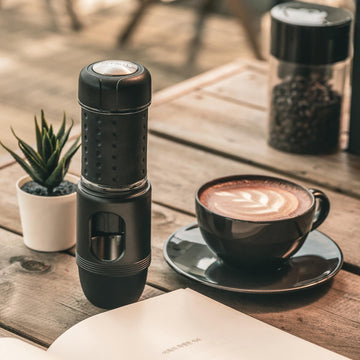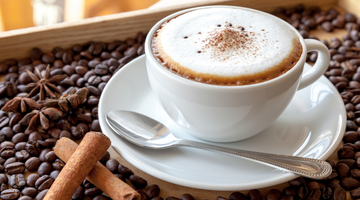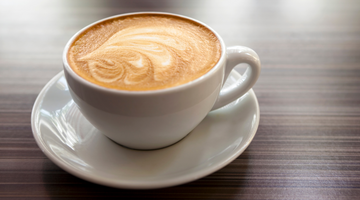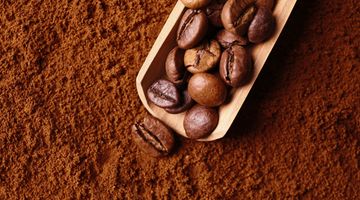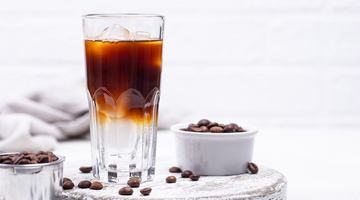Coffee isn't just a drink; it's a way of life. Whether you're a coffee newbie or a seasoned barista, understanding the nuances of your favorite brews can enhance your coffee experience. Today, we're diving into two popular favorites: espresso and cappuccino. If you've ever wondered what the difference between espresso and cappuccino is, you're in the right place. Let's break it down so you can sip smarter.
What is espresso?
Espresso, often described as the heart of Italian coffee culture, is a small but mighty shot of coffee. This concentrated brew originated in Italy in the early 20th century and quickly became the foundation for many other coffee drinks.

How to make espresso?
Making espresso is all about pressure. High-pressure water is forced through finely ground coffee to produce a rich, intense shot in about 25-30 seconds. This quick extraction creates a layer of crema on top, which is a sign of a well-made espresso.
Taste profile
Espresso is bold and robust, packing a punch of flavor in every sip. It's thick and syrupy and has a strong, lingering aftertaste. The crema adds a slight bitterness and smooth texture, making each shot a complex and delightful experience.
What is a cappuccino?
Cappuccino is another Italian classic, but it's a bit more elaborate than espresso. Traditionally enjoyed in the morning, cappuccino is a harmonious blend of espresso, steamed milk, and foam.

How to make cappuccino?
To craft a cappuccino, you start with a shot of espresso. Then, you add an equal amount of steamed milk, topped with a generous layer of frothed milk. The key to a great cappuccino is in the balance and texture of the foam, which should be velvety and not too stiff.
Taste profile
Cappuccino offers a delightful balance of intense coffee flavors with creamy milk. The steamed milk mellows the espresso's boldness, while the foam adds a light, airy texture. It's a more indulgent and creamy experience compared to a straightforward espresso.
Did you know you can make a perfect espresso anywhere with the STARESSO Portable Espresso Machine? This compact device uses the same pressure principles as a full-sized machine, delivering rich espresso shots on the go. Whether you're camping, traveling, or just at the office, STARESSO has you covered.
Main differences between espresso and cappuccino
Brewing process
Espresso:
-
Uses high pressure to extract coffee
-
Quick extraction time
-
Requires finely ground coffee
Cappuccino:
-
Starts with an espresso shot
-
Adds steamed milk and frothed milk
-
Requires a bit more time and equipment for milk frothing
Taste and texture
Espresso:
-
Intense and concentrated
-
Thick, syrupy texture
-
Bold flavor with a creamy crema on top
Cappuccino:
-
Balanced and creamy
-
Light, airy texture from milk foam
-
Milder coffee flavor with a smooth finish
Serving style and presentation
Espresso:
-
Served in small cups (demitasse).
-
Simple, no-fuss presentation.
Cappuccino:
-
Served in larger cups.
-
Often topped with foam designs or a sprinkle of cocoa powder.
Common variations of espresso and cappuccino

Variations of espresso
Ristretto: shorter extraction time, more concentrated flavor.
Lungo: longer extraction time, resulting in a milder taste.
Variations of cappuccino
Dry cappuccino: less steamed milk, more foam.
Wet cappuccino: more steamed milk, less foam.
Flavored cappuccino: add syrups like vanilla or caramel for extra sweetness.
The cultural significance of espresso and cappuccino
Espresso in Italian culture
In Italy, espresso isn't just a drink; it's a social ritual. Italians often enjoy it standing at a bar, chatting with friends. It's quick, strong, and meant to be savored in small sips.
Cappuccino in morning routines
Cappuccino is traditionally a morning beverage in Italy. Many Italians enjoy it with a croissant or other pastry. It's seen as too heavy to drink later in the day, but the rest of the world enjoys it whenever the craving strikes!
Health benefits and considerations
Benefits of espresso
Antioxidants: espresso is rich in antioxidants, which can help fight inflammation and protect your cells.
Low-calorie count: naturally low in calories, making it a good choice if you're watching your intake.
Benefits of cappuccino
Calcium intake: the milk in cappuccino is a good source of calcium.
Mood enhancement: the creamy texture and comforting flavor can boost your mood and provide a moment of relaxation.
In the grand showdown of espresso vs. cappuccino, it's clear that both have their unique charms. Whether you prefer an espresso's bold kick or a cappuccino's creamy delight, there's no wrong choice. Thanks to the STARESSO Portable Espresso Machine, you can enjoy both anytime, anywhere. So, go ahead, explore the difference between espresso and cappuccino, and elevate your coffee game.
Frequently asked questions about espresso and cappuccino
What is the difference between a latte and a cappuccino?
A latte requires more steamed milk and less foam compared to a cappuccino.
Can you make cappuccino with any type of milk?
Yes, you can use dairy or plant-based milk, though results may vary.
Is espresso stronger than regular coffee?
How many shots of espresso are in a cappuccino?
Typically, a cappuccino contains one shot of espresso.
